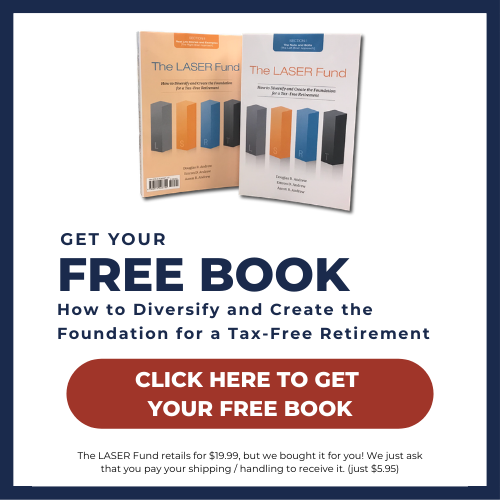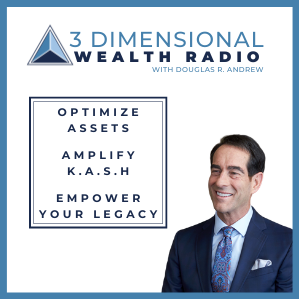What if you could generate an extra $1 million that could give you $100,000 a year of tax-free income for as long as you live?
The 3 Dimensional Wealth series on the secrets to a tax-free retirement can help you learn how to do exactly that.
TERM INSURANCE
Essentially, term life insurance guarantees payment of a predetermined death benefit if the insured (the person covered by the policy) passes away during a specified term (often 10, 15, or 20 years). If the term expires and the policyholder is still alive, the policy can be renewed for another term, converted into permanent coverage (such as whole or universal life insurance), or allowed to terminate.
Term life premiums are based on a person’s age, health, and life expectancy. You can choose a standard term life insurance policy (with annual renewable terms that go up each year, based on the mortality table), or you might choose a level-premium policy (with set premiums over the life of the term). Note that with a level-premium policy, you are essentially overpaying in the early years of the policy (paying more than the actual mortality cost at a younger age), but then you see savings on the back-end of the policy (when the actual mortality costs are higher).
WHOLE LIFE
Whole life is similar to a level-premium term policy, in that you pay a level premium for the life of the policy, but there are key differences. Unlike term insurance, whole life provides permanent death benefit coverage for the life of the insured (not just for a specified term). Whole life also adds the advantage of a savings component, where cash can accumulate on a tax-advantaged basis. You can choose to reinvest dividends into the policy’s cash value and earn interest.
There are variations of whole life. Some people don’t want to have to keep paying premiums their entire lives, so they choose a policy with a higher level premium until, say, age 65, at which point they can stop paying premiums. Or they can choose a 20-pay or 10-pay whole life policy, where they pay even higher premiums for 20 years or 10 years, then stop.
Essentially they are paying a certain premium based upon how much is going to be needed in excess, earning interest and dividends with the insurance company, to cover that cost of insurance as they get older, so no matter when they die, there is enough to cover the mortality cost and pay out the death benefit.
UNIVERSAL LIFE
Universal life insurance is another type of permanent life insurance (death benefit coverage for the entire life of the insured), that offers a cash value accumulation element.
The beauty of universal life insurance (and whole life) is the money inside of the policy accumulates tax-free. Life insurance is kind of a sacred cow in the Internal Revenue Code because policyholders are taking pressure off the government to provide for their heirs, such as widows, orphans, and so forth. The government incentivizes this behavior by allowing the money inside policies to grow tax-free, and the death benefit passes along to heirs income-tax-free in most circumstances.
Now let’s look at how universal life insurance came to be, and what makes it different.
A few decades ago, there was a product called single premium whole life insurance where you would pay this premium once. It might be really high, let’s say the life insurance death benefit is $1 million, and depending upon your age, you might have paid one single premium of $200,000 or $300,000. It was enough that with interest, the policy value would grow enough to equal $1 million at the time you would likely die, based upon your life expectancy.
E.F. Hutton looked at that and wondered, “What if you could use that tax-free death benefit while you’re alive?” It is possible, essentially, because you’re self-insuring.
In 1980, E.F. Hutton led the emergence of universal life, making it possible to take the least amount of insurance the IRS would let policyholders get away with under the IRS rules and put in the most premium. For example, say you put in $500,000 into your universal life policy. You’re not trying to get the maximum amount of insurance. Instead, you want your $500,000 to be accumulating value tax-free so that $500,000 can be generating $50,000 of tax-free income right off the bat if you want. Or so that $500,000 can double tax-free every seven to 10 years (based on historical interest rates) to $1 million in value tax-free, or doubling to $2 million in 14 to 20 years.
Say you were to retire with $2 million in your universal life policy that is generating 7% to 10% interest a year. You could borrow up to $200,000 a year out of your $2 million in cash value and use it as a living tax-free benefit. When you die, anything left behind transfers income-tax-free to your heirs.
Let me share with you why this is so important. There are 5 parties that are involved when you own a life insurance policy.
When universal life came out and it was primarily designed for living benefits more than for the death benefit, the parties to an insurance policy came into play more powerfully than ever before. There are five parties to an insurance policy:
The Insurer – This is the insurance company. They are the ones taking the risk that when you eventually pass away, they will have to pay out your death benefit. They know what they’re doing; they know what the mortality table is. They know that out of 1,000 people at your age, the number that will likely pass away each year. They calculate how much you need to pay into policy so they will have the wherewithal to pay out the death benefit. (As a side note – at 3 Dimensional Wealth we recommend legal reserve insurance companies who have legal reserves that are far more stringent than banks and credit unions. These are insurance companies that weathered the Great Depression with flying colors. In 2008 when over 400 banks and credit unions went under, there wasn’t one single legal reserve insurance company that went under. These are solid companies.)
- The Insured – This is the person whose death causes the death benefit to be paid to beneficiaries. (The owner is usually the insured, but it doesn’t have to be.)
- The Owner – This is the person who has the rights stipulated in the policy, such as naming beneficiaries, transferring ownership, etc. (This is often the insured, but it doesn’t have to be.)
- The Premium Payor – This is the person or entity who pays the premiums. (It is usually the insured and the owner, but it doesn’t have to be.)
- The Beneficiary – This is the person/entity who receives the death benefit income-tax-free when the insured passes away. It can be a person, trust, estate, or business. Typically you have to prove to the underwriter the beneficiary will suffer an economic loss by virtue of the insured’s death. But you can change the beneficiary after the policy is approved.
Let me share with you a little insight here. You can own an insurance policy on someone else if there’s an insurable interest. See, banks own insurance policies on their board of directors. This is called bank owned life insurance (BOLI). They want the tax-free accumulation and growth. The owner of the policy gets all that tax-free growth and tax-free income. It’s usually the insured, but it doesn’t have to be. I own life insurance policies on my children, on my wife, on my parents and in-laws. Because I’m the owner of the insurance for the tax-free death benefit and also the living benefits.
So I can be a premium payor on policies that cover my adult children, and the beneficiaries can be the grandkids for their college funding. I can use different insureds; I can own the policy or the trust can or what I call the Family Bank; so all these different parties come into play.
When you’re using universal life for retirement income, generally the owner is the insured but it doesn’t have to be. The owner can be your spouse, or another entity, or your trust.
There are a lot of dynamics here, and I want you to learn more about how powerful this is. This is why I co-wrote my 11th book, “The LASER Fund.” In the book, we describe how maximum-funded, tax-advantaged indexed universal life policies (what we call the LASER Fund) can offer unparalleled liquidity, safety, predictable rates of return, and tax advantages.
The book has 14 chapters loaded with charts, graphs and explanations to help you understand these complex principles in an easy-to-digest way. On the flip slide, there are 12 chapters with 62 actual client stories, helping you see the multiple ways you can use your indexed universal life policy for living benefits.
YOU’RE INVITED TO LEARN MORE
Claim your free copy of “The LASER Fund” book by going to LASERFund.com. Just pay for shipping and handling, and we will send it to you, absolutely free.
Watch the related YouTube video to see me explain “What Is the DIfference Between Term, Whole Life, and Universal Life Insurance” (and while you’re there, be sure to subscribe to my YouTube channel so you don’t miss a thing!).
Want to find out if a LASER Fund (a maximum-funded, properly structured indexed universal life insurance policy) is right for you? Join us for an upcoming webinar where you can explore these strategies.


